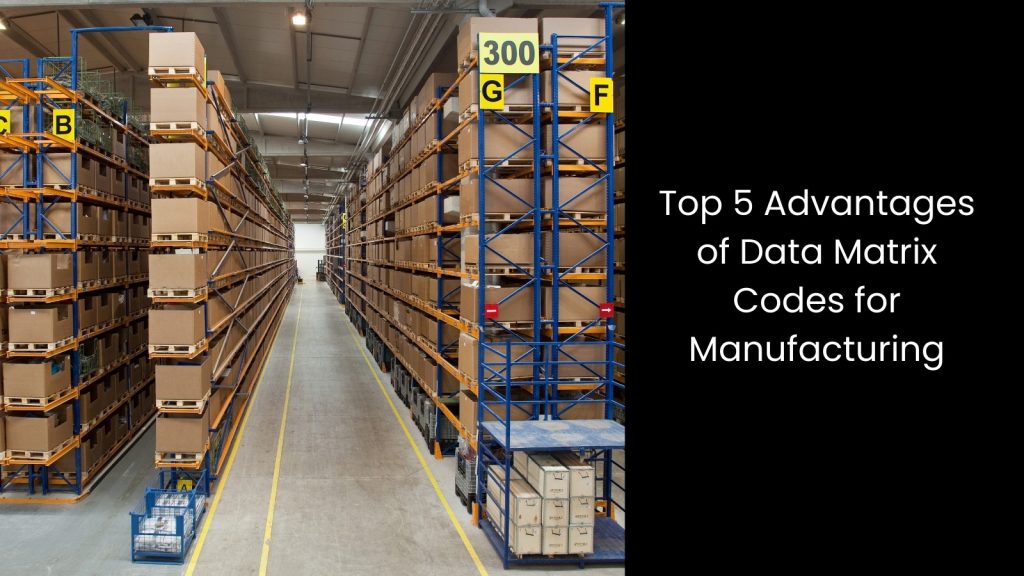This article will explore the advantages of Data Matrix Codes technology for the manufacturing industry.
What are Data Matrix Codes?

- Data Matrix codes represent a two-dimensional barcode technology that stores large amounts of information within a compact space.
- But where does its uniqueness lie? Unlike traditional barcodes that encode data in a single linear line, Data Matrix codes use a grid of black and white cells to encode alphanumeric or binary data. This design makes them highly efficient for small items and surfaces, enabling manufacturers to label components with detailed information like serial numbers, batch codes, or expiration dates.
- Data Matrix codes differ from other item tracking technologies, such as QR codes or RFID, through their compact size, robust error correction, and compatibility with various marking methods, including laser etching. While QR codes usually require more space and RFID relies on radio waves for tracking, Data Matrix codes excel in environments requiring precise, durable, and scannable marks.
- Their reliability and adaptability make them essential for healthcare, aerospace, and manufacturing industries today.
Top 5 Advantages of Data Matrix Codes for Manufacturing

Smaller Size
The manufacturing industry tends to choose Data Matrix codes because these two-dimensional barcodes offer a compact solution that outperforms traditional barcodes. Unlike linear barcodes, which require more space to encode additional information, Data Matrix codes use a grid of black and white cells to store large amounts of data within a small area. This feature allows manufacturers to add details like product IDs, batch numbers, or expiration dates without compromising the design or function of small items.
Their versatility makes them suitable for marking curved or uneven surfaces, such as medical vials, electronic components, or round containers. Data Matrix codes excel in their ability to store dense information in less space while remaining highly readable under challenging conditions.
Manufacturers can benefit from their robust error correction capabilities, which ensure accurate scanning even if the code sustains damage during production or handling.
This reliability, combined with the ability to mark them using various methods like laser etching or inkjet printing, makes Data Matrix codes a preferred choice for industries that demand precision and durability.
High Data Capacity
These two-dimensional barcodes store both alphanumeric and binary data, allowing manufacturers to encode complex product information such as serial numbers, batch IDs, and expiration dates within a compact design. Unlike traditional barcodes that require more space as the amount of data increases, Data Matrix codes efficiently organise vast information into a grid of black and white cells.
This capability enables manufacturers to meet strict regulatory and operational requirements without sacrificing product aesthetics or functionality. The high data capacity proves particularly valuable in industries like healthcare and electronics, where detailed labelling ensures safety, traceability, and compliance.
Manufacturers can easily integrate Data Matrix codes into production lines using laser etching or inkjet printing, which makes them adaptable to various materials like metal, plastic, or ceramic. These codes also remain scannable even when exposed to harsh environments, thanks to their robust error correction features.
As you can see, this reliability reduces misreads and improves overall operational efficiency.
End-to-End Traceability
Data Matrix codes provide comprehensive traceability, making them a preferred choice for tracking parts and components throughout their lifecycle. Let us explain how this occurs.
These two-dimensional barcodes enable manufacturers to encode essential details such as part numbers, production dates, batch IDs, and quality control data in a compact format. This wealth of information ensures that each item remains identifiable at every stage, from production and assembly to distribution and maintenance.
Walking ahead of those traditional barcodes, which may lack the capacity to store detailed data, Data Matrix codes allow manufacturers to create a complete digital history for each component.
This traceability proves vital for industries that must comply with stringent safety and regulatory standards. In the event of recalls or defects, manufacturers can quickly trace the affected components and take corrective actions, minimising risks and costs.
Improved Inventory Management
Data Matrix codes help solve this problem by improving inventory management through their ability to encode detailed item information. Manufacturers use these two-dimensional barcodes to label products with data like serial numbers, batch IDs, and expiration dates, ensuring precise tracking of each item.
This technology allows companies to monitor inventory levels in real time, reducing the risk of stockouts that halt production or overstocks that tie up resources and storage space. You know, traditional barcodes can only hold limited information. In contrast, Data Matrix codes pack a wealth of data into a small area, making them ideal for labelling even the tiniest components.
Their error correction features ensure readability under demanding conditions, such as in dusty warehouses or on worn labels, which keeps operations running smoothly.
Fast Scanning
Traditional barcodes generally require precise alignment for scanning. However, this differs from Data Matrix codes as the latter uses advanced technology to provide omnidirectional readability. This feature reduces the time spent on positioning and ensures seamless integration into automated systems. Production lines can benefit from rapidly scanning essential details such as serial numbers, batch IDs, and product specifications, allowing real-time monitoring and swift decision-making.
Their compact size and high data capacity make them ideal for labelling small or complex items, as we mentioned before. At the same time, their robust error correction ensures reliable performance even when codes are partially damaged or obscured. This reliability minimises downtime and prevents costly errors, keeping operations running smoothly.
Manufacturers also use Data Matrix codes in quality control processes, where speed and accuracy are critical to meeting tight production schedules. Whether tracking components in the automotive industry or managing medical device inventories, Data Matrix codes streamline workflows and enhance productivity.
Their fast scanning capability ensures manufacturers can meet the growing demands of modern supply chains while maintaining high efficiency and precision standards.
Cerexio Track and Trace Solution for Manufacturing World

Cerexio Track and Trace System revolutionises the manufacturing world as it is designed to offer real-time tracking of components, ensuring outstanding traceability and advanced inventory management. Its advanced analytics, AI, and ML integration capabilities enhance operational efficiency, minimise errors, and support compliance with industry standards, making it an essential tool for modern manufacturing processes.
Enhancing Traceability via Modern Technology

The key to enhanced traceability lies in selecting the right tracking technology. The right tools improve accuracy, minimise downtime, and ensure a seamless flow from production to delivery. So, why should you be waiting? Deploying modern tech is the game changer that will take your manufacturing efficiency to new heights, unlocking success and reliability for the long term.
